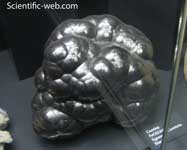| - Art Gallery - |
Goethite, named after the German polymath Johann Wolfgang von Goethe, is an iron bearing oxide mineral found in soil and other low temperature environments. Goethite has been well known since prehistoric times for its use as a pigment. Evidence has been found of its use in paint pigment samples taken from the caves of Lascaux in France. It was first described in 1806 for occurrences in the Mesabi iron ore district of Minnesota. Recently, nanoparticulate authigenic goethite was shown to be the most common diagenetic iron oxyhydroxide in both marine and lake sediments.[5] Composition It is an iron oxyhydroxide. Goethite's hardness ranges from 5.0 to 5.5 on the Mohs Scale, and its specific gravity varies from 3.3 to 4.3. The mineral forms prismatic needle-like crystals, but is more typically massive. Feroxyhyte and Lepidocrocite are both polymorphs of the iron oxyhydroxide FeO(OH). Although they have the same chemical formula as goethite they each have different crystalline structures making them distinct minerals. Usage Its main modern use is as an iron ore, being referred to as brown iron ore. It does have some use as a clay earth pigment. Iron rich lateritic soils developed over serpentinite rocks in tropical climates are mined for their iron content as well as other metals. Formation Goethite often forms through the weathering of other iron-rich minerals, and thus is a common component of soils. It may also be precipitated by groundwater or in other sedimentary conditions, or form as a primary mineral in hydrothermal deposits. Prevalence Goethite is found all over the planet, usually in the form of concretions, stalactitic formations, oolites (a form consisting of tiny round grains cemented together), reniform (kidney shapes) or botryoidal (globular, like bunches of grapes) accumulations. It is frequently encountered in the swampy areas at the head of spring waters ('bog iron'), on cave floors, and on the bottom of lakes and small creeks. The boxworks or gossan resulting from the oxidation of sulfide ore deposites is formed of goethite along with other iron oxides and quartz. Significant deposits of goethite are found in England, Australia, Cuba, and Michigan, Minnesota, Missouri, Colorado, Alabama, Georgia, Virginia, and Tennessee in the United States. Deposits significant in location, if not in abundance, have been found in Gusev by NASA's Spirit rover, providing strong evidence for the presence of liquid water on the planet Mars in an earlier stage of its development. References
See also * Ochre Retrieved from "http://en.wikipedia.org/" |
|
||||||||||||||||||||||||||||||||||

